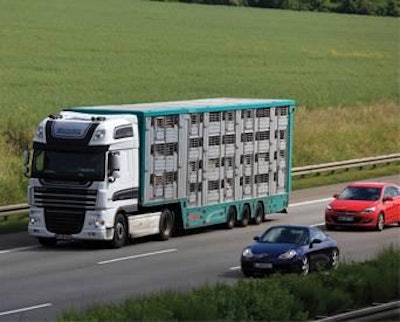
Livestock diseases are featured increasingly in both the general and industry media. While those of a zoonotic nature may cause particular panic, others can have a devastating effect on individual producers or regional economies. The news of continued outbreaks of porcine epidemic diarrhea (PED) virus in North America concerns local producers as well those in Europe, as reported in the previous issue. Incidences of foot and mouth disease (FMD) are still being reported, and porcine reproductive and respiratory syndrome (PRRS) is having significant effect on pig performance in certain regions. Classical swine fever (CSF) and other influenza viruses are also on the radar for pig veterinarians around the world. The spread of African swine fever (ASF) in Russia and Europe is of growing importance. Other diseases highlighted by industry professionals were swine dysentery, Illeatis and Japanese encephalitis, another zoonotic viral disease.
FMD
FMD affects all cloven-hooved animals, including pigs. It causes lameness and excessive salivation, along with blisters around the mouth and feet. Reduced appetite, depression and fever are observed, with obvious effects on productive performance. It is highly infectious, can be spread by the wind and creates the largest barrier to international agricultural trade.
Vaccination is carried in some regions where the disease is endemic, but in the EU, for example, it is not allowed. Here the main method of control is through slaughtering infected animals, and those they have come in contact with. As with ASF, FMD can also affect wildlife, so controlling those reservoirs of infection is an extra challenge.
Countries are taking steps to avoid the kind of devastating outbreak that occurred in the UK in 2001. While the EU member states are free of FMD, the disease still circulates in neighbor countries, as well as parts of Africa, the Middle East and South America. For example, the Balkan countries are close to infected countries and recently ran a simulation outbreak to test how prepared they were for outbreaks.
PRRS
PRRS is cased by a virus that invades macrophages, particularly in the lungs. By multiplying inside and killing the macrophages, the virus significantly reduces the immune capacity of pigs. It makes them very susceptible to other viruses and bacteria. Diseases, including pneumonia and meningitis, then take hold. Infertility, reduced farrowing rate and high numbers of stillbirths are also seen. Maintaining a high health status and improving biosecurity are two ways that producers have controlled the disease. There are no treatments for the virus but antibiotics are used to control secondary infections and several vaccines are available.
While PRRS has been an issue for many years, the emergence of highly-pathogenic versions of the virus have pushed it back into the limelight. These strains have been observed in the U.S. for some time and are having significant effects on pig production. There is serious concern from producers in Europe who had PRRS under control and don’t want to get these new strains. This virus, along with the swine influenza virus, has also been linked to outbreaks of porcine respiratory disease complex (PRDC) in finishing pigs.
CSF
CSF, also known as hog cholera, is another viral disease of pigs. It is a notifiable disease in most countries and is very similar to ASF; it is only distinguishable through laboratory testing. It is spread through direct contact with bodily fluids but can also survive for a long time in frozen carcasses. It causes high fever and loss of appetite, with a high level of mortality. Slaughter policies are most often used to control and hopefully eradicate this disease, as happened in the U.S. and the EU. Vaccinations are available and may be used routinely in endemic areas but are prohibited in other countries.
The disease is endemic in Southeast Asia, Africa, Central and Eastern Europe as well as parts of South America. Countries that border infected areas are at risk of being contaminated; for example, transmission from North back into the South of Brazil. As with ASF, wild boar are a carrier and countries including Germany, Austria and Poland need to protect their commercial herds. If these countries have an outbreak, then spread back into the EU is a distinct possibility. Controlling the movement of live pigs and pork products from infected areas is essential.
Disease control
Control of disease on any pig farm is of paramount importance. Any disease outbreak will result in a reduced pig performance and financial losses, irrespective of mortality rates. Whichever disease is being discussed, biosecurity is always key to controlling and preventing its spread. When outbreaks occur, advice is published, but as disease is a constant threat, biosecurity should be a top priority everyday.
The idea of a "magic bullet" to prevent these diseases is one that all those involved in the industry wish for. And while for some it isn’t possible, advances in vaccine technology is helping to control other diseases. The ability of biotech companies to develop vaccines much more quickly means that they can respond to the emergence of new diseases or virus strain mutations.
Future outlook
The challenge is to ensure that pig production is not seriously affected by disease outbreaks. In the modern world accurate data capture and fast communications is of significant benefit. This means that producers are quickly aware of disease outbreaks and organizations can effectively disseminate prevention strategies. Vaccine development is an important tool, but the importance of biosecurity should be reinforced.
The swine flu epidemic of 2009 still haunts the pig industry, as one that not only led to huge number of deaths in pigs, but also humans. Hopefully lessons have been learned on how to control such zoonotic diseases. Co-operation and coordination is essential between both agencies and countries, in terms of bio-containment. There is a balance to be stuck between the benefits of international trade and the risk of spreading disease. Presenting a united front on the control of disease is the best way for the pig industry to prevent financial losses.

















